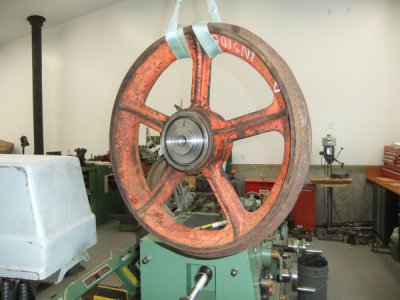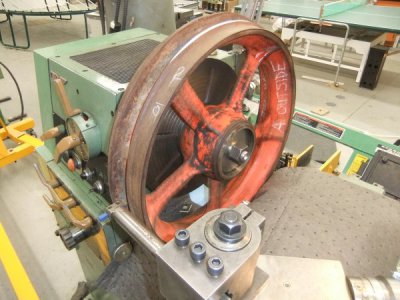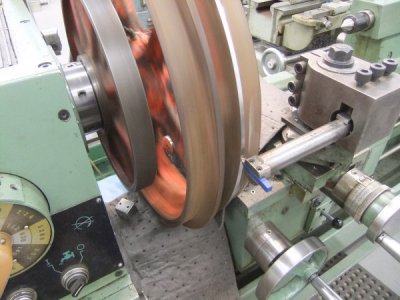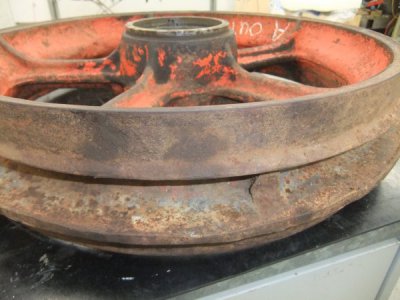- Joined
- Sep 25, 2014
- Messages
- 1,111
This is the biggest lump of iron I have ever worked over (about 100#). Buddy asked me if I could trim / clean up the front idlers on a small Case crawler he is resurrecting. The idea is to remove the one flange that is nearly worn away, and prep it for welding a steel ring on. The lathe manual says I can take 22" diameter in the gap. The wheels are 21.5" (so about a 1/4" clearance).
Fortunately the actual wheel is not much out of round. Because of the saddle wings, and the limited cross slide travel I had to hang way out. My slowest speed gives a surface speed of 250 fpm. The cutting goes pretty slow - things were complaining if I went with a DoC > 15 thou and a feed of .003 per rev. Needed to take about .6" off the radius.
The set up took most of the effort, I made steel plugs that fit the bearing bores very snug and piloted to my face plate. I then pulled the whole works in hard with a length of 1" threaded rod right through the headstock. I planned to put the tailstock center into the threaded rod, but I couldn't get it to reach or clear the compound (which is swung round backwards). I'll probably spend most of 30 hours (which seems just crazy long).
I'm guessing the typical approach would be to use a lathe over about 26", with about a >24" 4-jaw, grab it on the rim, dial it both ways and go. Then with the tooling in close enough, one could take a decent cut. I'm guessing a "real" shop would do this in just a few hours?




Fortunately the actual wheel is not much out of round. Because of the saddle wings, and the limited cross slide travel I had to hang way out. My slowest speed gives a surface speed of 250 fpm. The cutting goes pretty slow - things were complaining if I went with a DoC > 15 thou and a feed of .003 per rev. Needed to take about .6" off the radius.
The set up took most of the effort, I made steel plugs that fit the bearing bores very snug and piloted to my face plate. I then pulled the whole works in hard with a length of 1" threaded rod right through the headstock. I planned to put the tailstock center into the threaded rod, but I couldn't get it to reach or clear the compound (which is swung round backwards). I'll probably spend most of 30 hours (which seems just crazy long).
I'm guessing the typical approach would be to use a lathe over about 26", with about a >24" 4-jaw, grab it on the rim, dial it both ways and go. Then with the tooling in close enough, one could take a decent cut. I'm guessing a "real" shop would do this in just a few hours?





